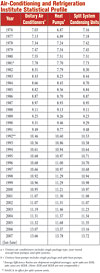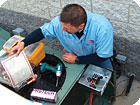
Chris Owen from Neese-Jones Heating and Cooling in Alpharetta, Ga., services a 13 SEER Ruud cooling unit. The average SEER rating for unitary air conditioners sold through June this year is 13.66, up from the final average of 13.07 SEER for all units sold in 2006.
Energy-efficient products are gaining ground in the residential sector. Industry-wide statistics indicate that through June of this year, about five out of every six air conditioners and condensing units sold to homeowners were 13 SEER.
According to information compiled by the Air-Conditioning and Refrigeration Institute (ARI), the average SEER rating for unitary air conditioners sold through June of this year is 13.66 (see statistical profile chart below). That’s a substantial jump from the 13.07 SEER average for all unitary units sold in 2006. Unitary air conditioners include single-package type, year-round (except heat pumps), and split systems.
The SEER average is higher for heat pumps and split system condensing units sold through June of this year. According to ARI, the average SEER rating for split system condensing units is 13.72, up from the 13.16 SEER average for all of 2006. The SEER average for unitary heat pumps, which includes single package and split, is 13.78, up from the 13.37 SEER average for all units sold in 2006.
When the previously mandated SEER rating jumped from 8 SEER to 10 SEER in 1992, acceptance to higher efficiency was a bit slower. According to ARI, the average SEER rating for unitary air conditioners sold in 1992 was 10.46.
A year later, the average only increased to 10.56 SEER. In regard to heat pumps, the SEER average of 10.86 for 1992 increased to 10.86 for 1993.
If the economic environment were in better shape today, many industry insiders believe more of the higher-efficient units would be selling in 2007.
EVERYONE IS SMILING
These facts may not be too surprising especially since the new 13 SEER efficiency standard for residential central air conditioners and heat pumps took effect more than one and a half years ago. However, what makes manufacturers, distributors, and contractors smile is the fact more and more homeowners are looking beyond 13 SEER. Industry-wide, the SEER sales segmentation is approximately 9 percent for 14 SEER, 3 percent for 15 SEER, 2 percent for 16 SEER, and 2 percent for SEER 17 and above.“High-end sales are going very well with all Johnson Controls brands,” commented Andy Armstrong, director of marketing, Johnson Controls Inc., Unitary Products.
“We’ve seen our customers offering higher-end systems, not only on the efficiency side, but equally important on the comfort side. Two-stage air conditioners/heat pumps, as well as modulating furnaces, are both seeing strong growth this year. Our premium system sales are up over 500 percent in the past three years.”

a = Unitary air conditioners includes single package type, year round (except heat pumps), and split systems.
b = Unitary heat pumps includes single package and split heat pumps.
* Energy Efficiency Ratios are shipment-weighted averages. 1976-1980 are EER; 1981-2002 are SEER. (Note: EER and SEER are not comparable.)
** NAECA in effect for split system units.
Shipment-weighted Seasonal Energy Efficiency Ratios of unitary air conditioners, unitary air-source heat pumps, and split system condensing units (under 65,000 Btuh) (Source: Air-Conditioning and Refrigeration Institute.)
b = Unitary heat pumps includes single package and split heat pumps.
* Energy Efficiency Ratios are shipment-weighted averages. 1976-1980 are EER; 1981-2002 are SEER. (Note: EER and SEER are not comparable.)
** NAECA in effect for split system units.
Shipment-weighted Seasonal Energy Efficiency Ratios of unitary air conditioners, unitary air-source heat pumps, and split system condensing units (under 65,000 Btuh) (Source: Air-Conditioning and Refrigeration Institute.)
When the economic picture changes, Sinkler expects even better results. “We need to have a realistic perspective, especially in these times of $3-a-gallon gasoline, galloping commodity prices, declining consumer confidence in the economy, endless bad news housing reports, and other political distractions,” he said.
“Today’s homeowners who are looking for a new cooling system must evaluate their options and make a determination on what best suits their home comfort needs and budget. In reality, even with a great sales presentation that explains the economic advantages of higher SEER products, most consumers buy 13 SEER because they’re trying to manage higher costs with their ability to pay.
“Some consumers will decide to invest in a higher SEER system up front, based on the expectations of increased energy efficiency, lower utility bills, and enhanced warranties.”
Sinkler noted that his company’s KwikComfort Financing and Protection Plus extended service programs are increasingly being used by consumers that want higher SEER products but cannot manage the cash outlay.

A technician from Biewer Heating and Cooling in Chicago services a Rheem condensing unit. The manufacturer said its 14 SEER units are selling “a bit stronger” than what the company projected for 2007.
The NEWSwas unable to obtain industry statistics for the commercial sector. However, the general consensus is that the commercial market is not necessarily embracing higher-efficiency equipment as fast as the residential sector.
“Commercial sales have certainly seen major changes in the efficiency landscape. However, the greater percentage of these changes is tied to governmental regulations on a state-by-state basis,” commented Armstrong.
“In rare cases, engineers, building owners, and national accounts are taking a proactive approach to efficiency, but this is the exception and not the rule. It is very clear, however, that there is considerably more discussion about efficiency in commercial products than we’ve seen before.”
Publication date:09/10/2007

Report Abusive Comment